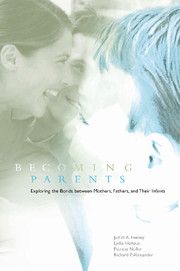Book contents
- Frontmatter
- Contents
- Preface
- 1 The Transition to Parenthood
- 2 Attachment in Childhood and Beyond
- 3 The Study
- 4 The Couples
- 5 Pregnancy and Plans for Birth
- 6 Couples' Experiences of Birth and New Parenthood
- 7 How Does New Parenthood Affect Couples?
- 8 Dealing with Depression
- 9 Men, Women, and Household Work: The Diaries
- 10 Couples' Changing Attachment Relationships
- 11 Six Months into Parenting
- 12 New Parenthood in Perspective
- Appendix A Core Questionnaires Completed by Couples
- Appendix B Summary of Sample Characteristics
- Appendix C Summary of Major Statistical Analyses
- References
- Author Index
- Subject Index
6 - Couples' Experiences of Birth and New Parenthood
Published online by Cambridge University Press: 05 June 2012
- Frontmatter
- Contents
- Preface
- 1 The Transition to Parenthood
- 2 Attachment in Childhood and Beyond
- 3 The Study
- 4 The Couples
- 5 Pregnancy and Plans for Birth
- 6 Couples' Experiences of Birth and New Parenthood
- 7 How Does New Parenthood Affect Couples?
- 8 Dealing with Depression
- 9 Men, Women, and Household Work: The Diaries
- 10 Couples' Changing Attachment Relationships
- 11 Six Months into Parenting
- 12 New Parenthood in Perspective
- Appendix A Core Questionnaires Completed by Couples
- Appendix B Summary of Sample Characteristics
- Appendix C Summary of Major Statistical Analyses
- References
- Author Index
- Subject Index
Summary
“Our everyday talk just isn't there any more, because suddenly all the focus is on the baby. And although that brings a lot of joy, you also start to notice those things that have dropped away.”
About six weeks after their babies were born, we again visited the transition couples in their homes. As on the first occasion, we interviewed each husband and wife as a couple, and tape-recorded the discussion (92 couples were interviewed at this second phase of the study). This interview focused on two broad issues: how the couples had coped with the labor and birth, and how they were reacting to the early days of parenthood.
LABOR AND BIRTH
In this interview, we directed the first three questions about the experience of labor and birth primarily at wives. We asked them to talk about the length of their labor, the types of pain relief used, and the extent of surgical intervention. These questions were designed to allow wives to share their experiences, and to give us some indication of the relative ease or difficulty of the birth.
Ease or Difficulty of Birth
Not surprisingly, wives' answers to these questions revealed widely differing experiences. The number of hours in labor ranged from 1 to 48, with about half of the wives reporting labors of 11 hours or more. The huge range of answers to this question undoubtedly reflects not only the variability of labor itself, but also the difficulty in defining the start of “labor,” without information from the attending health professionals.
- Type
- Chapter
- Information
- Becoming ParentsExploring the Bonds between Mothers, Fathers, and their Infants, pp. 88 - 109Publisher: Cambridge University PressPrint publication year: 2001



